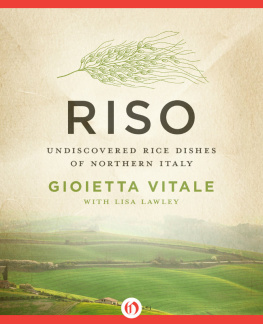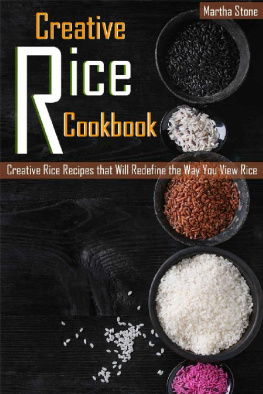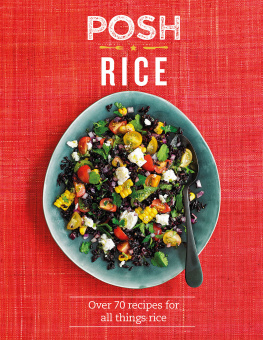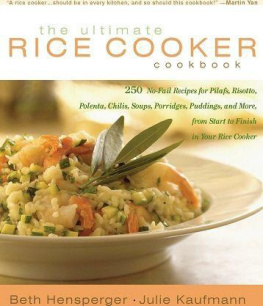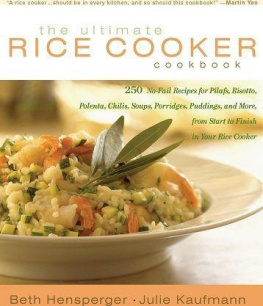
Riso
Undiscovered Rice Dishes of Northern Italy
Gioietta Vitale

To my mother and father, who taught me how to enjoy the beauty of the simplest gifts of nature
Introduction
THIS BOOK IS DEDICATED entirely to ricespecifically Northern Italian rice and its various uses. Having grown up in Milan and lived in New York for many years, Im delighted to see the flurry of interest here in risotti, the classic rice dishes of my home region. However, I would like to emphasize that the Northern Italian appreciation of rice goes much further than risotti; like pasta in the south, the grain is an important ingredient in many of our favorite dishes. In fact, you might say it is our pasta. It is my pleasure to share with you here a number of dishes using ricesoups, salads, primi piatti, and desserts (though not too many of these last)that I have enjoyed serving over the years.
The earliest written reference to rice cultivation in Italy dates from the fifteenth century, but rice probably was introduced to Italy in the tenth century, most likely as a result of the Saracen invasion. These marauding Arabs brought to Sicily and the mainland some of their favorite foods, including citrus fruits, sugarcane, and almonds. The history of ricethe edible seeds of an annual grassis considerably more ancient than its appearance in Italian cuisine, possibly even older than wheat. The first confirmed site of rice cultivation was at what is now Non Nok Tha, Thailand, in about 3500 B.C. From there, during the next two millennia, rice cultivation slowly spread to China and India, where it became an important staple food and was eventually passed to the Arabs in the course of trade. According to the International Rice Research Institute in the Philippines, approximately 30,000 varieties of rice existalthough by another count, as many as 30,000 varieties may once have been cultivated in India alone. Today rice is grown in almost every part of the world, and total production is estimated at 400 to 420 million tons per year.
In Italy, rice is cultivated in waterplanted in April and ready to harvest by September. The rice grown along the Po Valley in Piedmont, Lombardy, Emilia, and Veneto has special properties that have lent it to a wide variety of uses. This rice has the ability to absorb large amounts of liquid while retaining the shape of the grain and remaining firm. And the grains of Italian rice, when cooked, release just the right amount of amylopectin (a type of starch) to enable the grains to cling nicely without becoming glutinous or sticky.
Arborio rice is the Italian rice most widely available in the United States, where it can be found in many supermarkets as well as in gourmet food shops and on page 12 lists the other Italian types and their properties. You may substitute them for the Arborio where appropriatebut you are unlikely to run into the other varieties very often in this country. Most Arborio rice sold in the United States is packaged in cloth or cellophane bags and has been thoroughly cleaned. (If you happen to buy your rice in bulk, you will need to pick over it carefully and wash it in cool water a couple of times before cooking.) In the summertime, or if you live in a hot, humid part of the country, its best to buy only as much rice as you can use in a week. Store the rice in a tightly sealed container to prevent the oils in the grains from breaking down and turning rancid when exposed to the air. This way your rice will always have the freshest possible taste.
The cooking times given in the recipes and the on page 12 are approximate. The altitude, humidity, and individual properties of your stove may affect the cooking time, so it is very important that you taste the rice near the end of the suggested cooking time. If the rice is al dentefirm to the bite, but with no chalkiness at the centerremove the rice from the heat and serve immediately. Otherwise, the rice will continue cooking even after it has been removed from the stove. (Some recipes that require further preparation call for the cooked rice to be rinsed immediately in cool running water; this is to arrest the cooking process and keep the rice from becoming mushy.)
Aside from this caution, however, you will find the recipes in this book simple and quick to prepare, a boon whether you are cooking for guests or for your family. Some of the dishes are robust and warming while others are ultralightthe perfect showcase for perfect summer fruits and vegetables. Best of all, rice is an extremely healthful food. Its complex carbohydrates make it easy to digest (remember when plain rice was a commonly prescribed treatment for an upset stomach?) and rich in B vitamins, iron, and calcium. In addition, most of the recipes in this book contain only small amounts of butter, cream, or meat, and quite a few are entirely vegetarian. Once you become acquainted with the Northern Italian way with rice, I am sure you will agree that this venerable grain has at least as much to offer the busy American cook as pasta.
Italian Rice Varieties
| TYPE OF RICE | TRADE NAME | SHAPE | USE | COOKING TIME |
| Ordinario (common) | Balilla | fat and round | cakes
soups | 10 minutes |
Semirefined
(semifino) | Maratello | medium long | soups
risotto | 15 minutes |
Fine
(fino) | R.B. Razza 77
Vialone | long | risotto | 16 minutes |
Super-refined
(superfino) | Arborio
Carnaroli | long and fat | risotto | 18 minutes |
Some Notes on Ingredients
HERBSItalian food is a cuisine of simple, clear tastes. Often the flavor of a dish is built around a single herb or, at most, two complementary herbs. For this reason, it is best to use only fresh herbs, which give the strongest, truest flavor, when preparing the dishes in this book.
BASIL is probably the herb I use most often. This annual plant, which grows in the worlds temperate and subtropical regions, is widely cultivated for kitchen purposes and is believed to be an excellent soothing element for upset stomach symptoms as well as for headache relief. Basil may be seeded in greenhouses in March or April, or outside if it is brought inside the house at night. By May, it is safe to transplant the young plants outdoors, where they will need frequent watering. The plants will send up spikes of white or pinkish flowers. When picking basil leaves for cooking, pinch off the tops of the plants in a cluster (never pinch off single leaves). Pinching the tops encourages the basil plant to develop in a bushy, full shape and to send out new shoots that will keep you in basil all summer long. Since basil is an annual, it wont last forever, but you can extend the life of your plants by potting and bringing them indoors before the first frost in October or November. The pots should be placed in a sunny window. Luckily, when your homegrown basil runs out, these days you can usually buy fresh basil in the supermarket year-round. Fresh basil has a strong, pungent aroma, and your food wont need any other seasoning. The leaves have an oval shape and a deep green (or sometimes purple) color that makes a beautiful decoration for a platter.
PARSLEY is a biennial plant of the carrot and parsnip family that originated in Europe. It is widely used as both a garnish and a flavoring for food. It has deep green, aromatic leaves and comes in two varieties: curly and flat-leaf. Some people think the flat-leaf variety is more aromatic than the curly parsley, which perhaps looks more attractive on a plate. Parsley is very easy to cultivate and spreads profusely in the garden with little encouragement.
Next page
